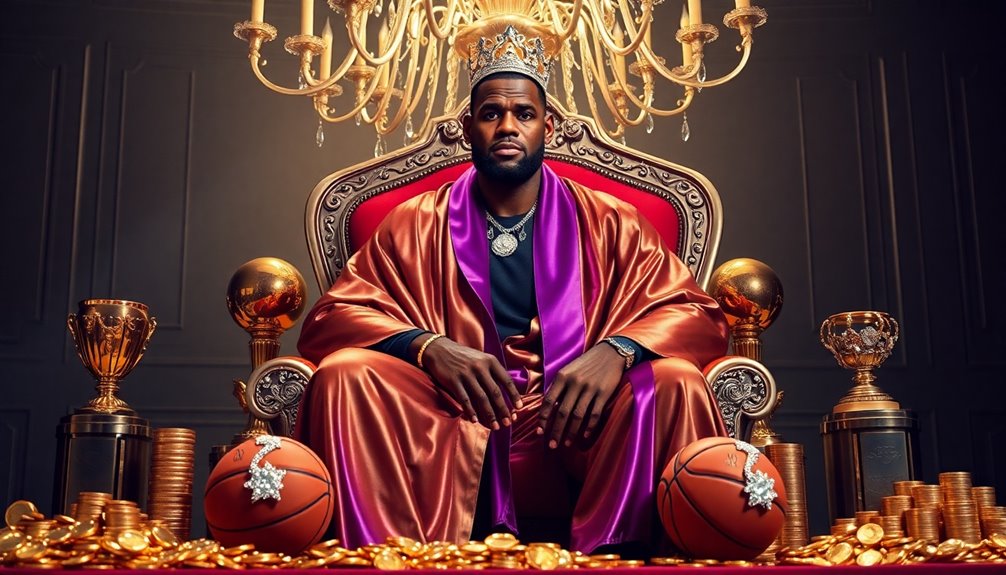Shohei Ohtani’s record-breaking contract highlights his unique value as a two-way star, blending exceptional pitching and hitting skills that reshaped how players are valued. His versatility and marketability command premium pay, encouraging teams to reassess traditional metrics and consider overall contribution. This historic deal signals a new chapter in baseball’s financial landscape, emphasizing multi-dimensional talent’s importance for future success. To understand the full scope of Ohtani’s remarkable worth, there’s more to explore.
Key Takeaways
- The contract’s record-breaking value reflects Ohtani’s unique two-way talent, emphasizing his versatility as a premium asset.
- It redefines player valuation models by prioritizing overall contribution from both pitching and hitting roles.
- Marketability and fan appeal significantly boosted Ohtani’s worth, leveraging his dual impact on team success and engagement.
- The deal signals a shift in negotiations, rewarding multi-dimensional players beyond traditional stats.
- This historic contract sets a new standard, highlighting the increasing value of two-way athletes in baseball’s financial landscape.

Shohei Ohtani has just signed a contract that shatters previous records, signaling a new era in baseball negotiations. This deal sets a new standard for how teams evaluate player valuation, especially for athletes who excel in multiple roles. As you follow the details, it’s clear that the negotiations surrounding this contract weren’t just about dollars; they reflected a groundbreaking acknowledgment of Ohtani’s unique talent. Teams now realize that a player who can dominate both as a pitcher and hitter offers unparalleled value, shifting the traditional approach to contract negotiations. This deal isn’t just a payday for Ohtani—it’s a statement that versatility and exceptional skill can command premium compensation.
Ohtani’s record-breaking contract redefines player value, emphasizing versatility and multi-role dominance in baseball negotiations.
When you look at the specifics of the contract, it’s obvious that teams are willing to pay a premium for a player of Ohtani’s caliber. They’ve recognized that his rare two-way ability doesn’t just boost his individual worth—it also enhances the overall value of the team. This has led to a reevaluation of how player valuation is determined, especially for those who bring multiple skills to the table. Instead of being pigeonholed into a single role, Ohtani’s contract reflects an understanding that his contributions far exceed typical expectations. This shift in perspective is reshaping how clubs approach negotiations, encouraging them to consider the full scope of a player’s impact on and off the field.
During the negotiation process, it’s clear that Ohtani’s performance history and marketability played a pivotal role. His ability to excel in both pitching and hitting makes him a unique asset, and teams are now factoring this dual value into their offers more than ever before. This approach is changing the traditional valuation models, which often focus narrowly on batting averages or ERA. Now, teams are factoring in the all-encompassing contribution a player like Ohtani can make—on the mound, at the plate, and in terms of drawing fans. The result is a contract that rewards not just past performance but also future potential, signaling a shift toward more holistic player valuation. Additionally, the evolving understanding of player valuation underscores how innovative contracts like Ohtani’s are reshaping the sport’s financial landscape.
As you watch the fallout from this historic deal, it’s evident that the landscape of baseball contracts will never be the same. Ohtani’s contract demonstrates that embracing multi-dimensional talent can lead to record-breaking negotiations. Teams will increasingly seek out players who can fill multiple roles, and the valuation models will evolve to reflect this reality. For fans and analysts alike, this deal marks a new chapter, where the true worth of a player isn’t just measured by stats but by the broader impact they can have on the game’s future.
Frequently Asked Questions
How Does Ohtani’S Contract Compare to Other MLB Superstar Deals?
You’ll notice Ohtani’s contract far surpasses typical MLB superstar deals, setting new contract benchmarks. His unique two-way skills justify higher salaries and highlight the growing salary disparities among top players. Compared to other stars, Ohtani’s deal reflects his rare talent, blending pitching and hitting, which elevates his value beyond traditional benchmarks. This contract reshapes expectations and emphasizes how extraordinary performances can directly influence salary standards across the league.
What Are the Long-Term Financial Implications of Ohtani’S Contract?
Considering contract longevity, you’ll want to weigh long-term financial stability against potential tax implications. Ohtani’s deal promises a prosperous path, but extended contracts can expose you to increased taxes and financial fluctuations. You must monitor market movements, manage money wisely, and anticipate possible adjustments. Ultimately, understanding these long-term factors helps you make more mindful, meaningful money decisions, maximizing your earning potential while minimizing unforeseen financial setbacks.
How Does Ohtani’S Two-Way Performance Impact His Value?
Your understanding of Ohtani’s two-way performance shows how his dual role versatility boosts his value. His pitching-hitting synergy makes him a unique asset, impacting team dynamics and strategic options. This blend of skills not only elevates his overall contribution but also increases his market worth, as teams see him as a rare talent who can excel in multiple roles. His performance directly influences his perceived value in the league.
Will Ohtani’S Contract Influence Future Player Negotiations?
Your question about Ohtani’s contract influencing future negotiations is spot on. His record-breaking deal sets a new standard, giving players more leverage in contract talks. Teams might now face higher expectations for two-way players, which could push negotiations toward larger salaries. As a result, Ohtani’s success could reshape how players and teams approach contract negotiations, emphasizing the value of versatile talent and potentially elevating future player earnings.
What Are the Potential Risks Associated With Such a Record-Breaking Deal?
You should consider that record-breaking deals come with significant risks, like injury risks that could limit your performance or career longevity. Market volatility also plays a role; if your performance declines or injuries happen, your value might drop unexpectedly. These factors make such contracts risky, even if they seem like a fantastic deal now. Always weigh the potential rewards against these uncertainties before committing to a high-stakes agreement.
Conclusion
As you picture Shohei Ohtani on the mound, his bat poised, the crowd roars in anticipation. His record-smashing contract isn’t just a number; it’s a symbol of his extraordinary talent and relentless drive. This two-way star has transformed the game, blending power and precision. As you follow his journey, remember—his worth isn’t just measured in dollars but in the electrifying moments that leave fans breathless and the sport forever changed.









